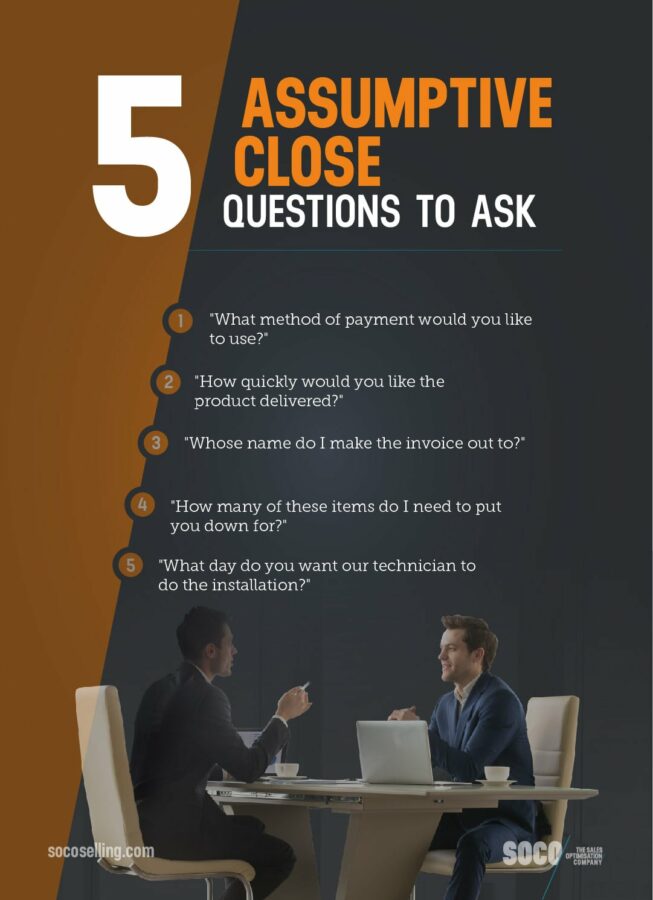
In theory, if you’ve done everything right up until the final moment, closing the sale should be a piece of cake. So far, you’ve identified your customer’s pain points, helped them uncover related issues and proposed how your solution will solve them. But for some reason, even sales professionals with advanced sales skills have trouble asking for the sale without being pushy (or feeling as if they are.) Considering this is a common issue that affects many sales professionals’ careers from advancing, we’ve created a mini-guide containing the best tips to help you ask for the sale without being pushy but also without being too passive.
When it comes to sales, there’s a fine balance between being too passive and too aggressive, skew too far in either direction and your sales results will suffer.
Also read:
- Why Everyone Should Work in Sales at Least Once in Their Life
- Good vs Bad Salespeople
- What Assets are Needed to Succeed in Sales?
Why you need to avoid pushy sales tactics
Salespeople don’t always have the best reputation; we’re often stereotyped as aggressive, pushy and dishonest. If this is your customers’ impression of you, can you blame them for becoming suspicious when you attempt to aggressively or over-eagerly sell to them? Logically, they assume you have an ulterior motive, one that definitely won’t benefit them – but will only help you profit. The result is that you’ve lost them before you’ve even had a chance to show them how your solution can help solve their problem. Instead, they’re worried that they’re going to lose money – so they become defensive and shut down. When a prospect is unwilling to engage, you’ve lost all respect, trust and credibility with them from that point onwards. In other words, you’ve already lost the sale.
When do I ask for the sale?
A hiccup for many is deciding when to ask for the sale, but many forget that you can always identify the signals that someone is ready to buy. The first most obvious signal is that they’re asking you many questions about how your service works. In this instance, they’re actively envisioning how it would be to work with you and your solution – which indicates they’re ready to buy. Another signal someone is ready to buy is that they’ll ask to see proof devices for a second or even a third time. When customers do this, they’re simply taking a closer look at the facts and benefits of your offering.
While these examples are an excellent starting point to ask for the sale, you should be mindful not to be passive. Remember, closing a sale can suffer from either a too-passive approach or a too-aggressive one.
Also read: 15 Top Sales Closing Techniques To Increase Close Rates
How To Ask For The Sale Without Being Pushy
Now, you might be sure of when to ask for the sale but still lack the confidence to follow through. Keep reading to discover our tips for asking for the sale without being pushy below:
1. Prepare for rejection
One of the biggest hurdles for salespeople when asking for a sale is overcoming the fear of rejection. No one likes to feel rejected, but try not to take it personally – just because the buyer said no now doesn’t mean they won’t want your product or service in the future.
It just means they’re not ready to buy just yet. Ultimately the sooner you learn how to deal with rejection and failure without letting it affect your outlook or job performance, the better.
2. Listen to your buyer’s needs
Sales professionals should listen 80% of the time and only talk 20% of the time. Of that 20%, half of that should be asking questions, which leaves only 10% for selling and telling.
Therefore, if you focus intently on your prospect’s information about their problem, you can better formulate a personalised offering that they’re more likely to buy. Rather than an unappealing one size fits all type of deal.
3. Improve your confidence
When you lack confidence in yourself and your offering, prospects notice. Imagine two equally knowledgeable and skilled people offering the same product or service. One has a positive attitude while the other has a negative attitude.
I guarantee that the one with the positive attitude will outperform the one with the negative attitude every time. How do you combat a negative mindset? Write down your most outstanding sales or life achievements. Then use this as a daily reminder of motivation and inspiration.
4. Assume the sale
While we already know that closing a sale can suffer from either a too-passive approach or a too-aggressive one. The assumptive close, also known as the presumptive close, solves this problem. It’s called the assumptive close because the salesperson assumes the prospect is ready to buy. Instead of the salesperson saying ‘Are you ready to buy?’ they assume the sale by asking questions like ‘Would you like me to arrange for delivery on Monday?’
Ultimately, the assumptive close keeps you in control of the sales momentum by skipping past the whole question of whether the customer wants to buy. In this approach, you assume that the sale is as good as done.
5. Leverage urgency
By leveraging a sense of urgency, you’re communicating to your prospect that it’s crucial to act promptly, decisively, and without delay. Otherwise, you’ll risk losing out on a valuable offering. For instance, “If you decide to purchase today, you’ll be one of the last customers to receive 20% off your entire order.”
6. Share social proof
The great thing about social proof is that it’s your actual customers telling the story of how your solution solved their problem. Naturally, prospects are more likely to agree to the deal if they’ve seen other people benefit from your solution.
To achieve this, ensure you have plenty of social proof available when meeting with your prospect. That way, when it comes to asking for the sale, your prospects will already feel good about your offering.
7. Use storytelling
Study after study shows that people are more receptive to stories than almost any other type of communication. Our brains not only crave stories but to remember them. As such, we pass on meaningful ones to others. That’s why incorporating storytelling into asking for the sale is so effective.
You can do this by creating a hero with a name, a personality, and a practical problem to overcome. But, you must take great care when deciding how to reflect your intended message. Ensure your storytelling speaks to your customers. You can do this by including the same hopes, ambitions, fears, regrets, and disappointments they have.
Need help crafting your message? Our unique workshop, Storytelling In Sales, equips you with the knowledge and application skills to plan engaging and relevant business pitches. Get immediate access now and learn how to execute results-oriented pitches. All while demonstrating your ability and track record to solve problems.
8. Attempt a Trial Close

You can always use a trial close to gauge your customer’s willingness to move forward. However, many people are hesitant to try a trial close because they’re afraid of objections, and what’s more – they’re scared of questions. Don’t be! Because if they’re asking, that means your customer’s engaged and interested. So use these trial closes to get a sense of where your customer are at, and it will help you address potential roadblocks and objections while they’re small before they get bigger. For example:
- “Does this make sense?”
- “Have I explained it clearly? Do you understand? Is this clear?”
- “Do you see how this can help companies?”
- “Do you see how this could help your company?”
- “How does that sound?”
- “What do you think?”
- “What’s missing?”
- “Does this cover everything?”
9. Ask an assumptive close question

The idea with these assumptive close questions is that you’re no longer asking permission to make the sale — you’ve already made the sale as far as you’re concerned. In other words, you’ve answered “Yes” on the customer’s behalf. For example:
- “What method of payment would you like to use?”
- “How quickly would you like the product delivered?”
- “Whose name do I make the invoice out to?”
- “How many of these items do I need to put you down for?”
- “What day do you want our technician to do the installation?”
How not to ask for the sale
We’ve covered how exactly to ask for the sale without being pushy. But be careful not to run into these common mistakes that many underconfident salespeople make:
Rely on incentives to tempt prospects
It can seem tempting to sweeten up your prospect with incentives before explaining your solution’s benefits. But honestly, many salespeople lead with “I have the lowest price – I’ll give you a good deal’. Yet, no matter how hard you try, no one will buy something, no matter how cheap it is if they suspect it won’t work. Doing so would be a waste of their money.
Be in-direct
Communication is vital when asking for a sale. That’s because it is the foundation of rapport and understanding. If you can’t directly ask your prospect for what you want, they won’t be able to reply how you want them to.
As such, you should never retreat to using vague language. Not only will your prospect probably become confused, but their patience will wear thin. Again, this will potentially cost you the sale you could have made had you said, “would you like to sign?”
Wait for the prospects to ask first
Unfortunately, you can’t just explain to your prospect how your solution solves their problem, stand back and wait for them to ask where they can sign. By waiting for your prospect to start asking how you can move along, you’re wasting valuable time that you could be using to expand their knowledge of your other products. In other words, your chance to upsell and cross-sell. Not only that, but you’ll radiate a vibe that your solution is untrustable because you have no confidence in it- which could cost you the sale.

Maximise your sales skills in only 12 weeks with personalised 1-1 coaching
You’re good at what you do, but you know there’s the next level.
That’s where our 12-week intensive Sales Mastery program comes in.
Our individual sales coaching program involves a tailored learning system consisting of e-learning, six 1-on-1 coaching sessions and email support.
We call it ‘intensive’ because it is – during the 12 weeks, you’ll be working on your sales skills, gathering and documenting your sales process, crafting new scripts and working on perfecting your craft.


